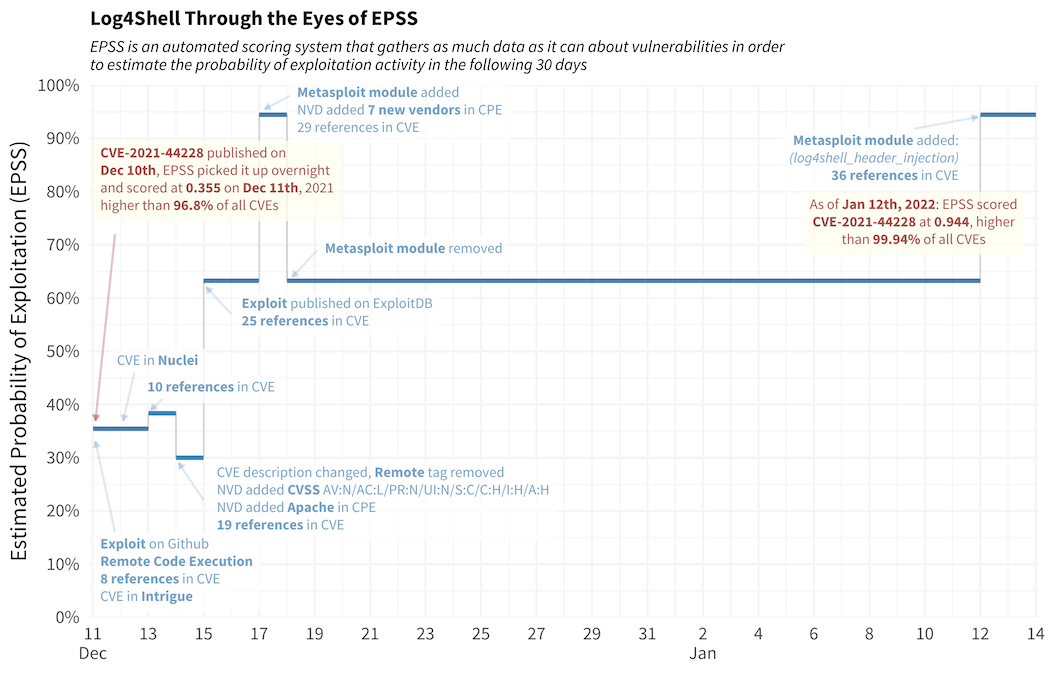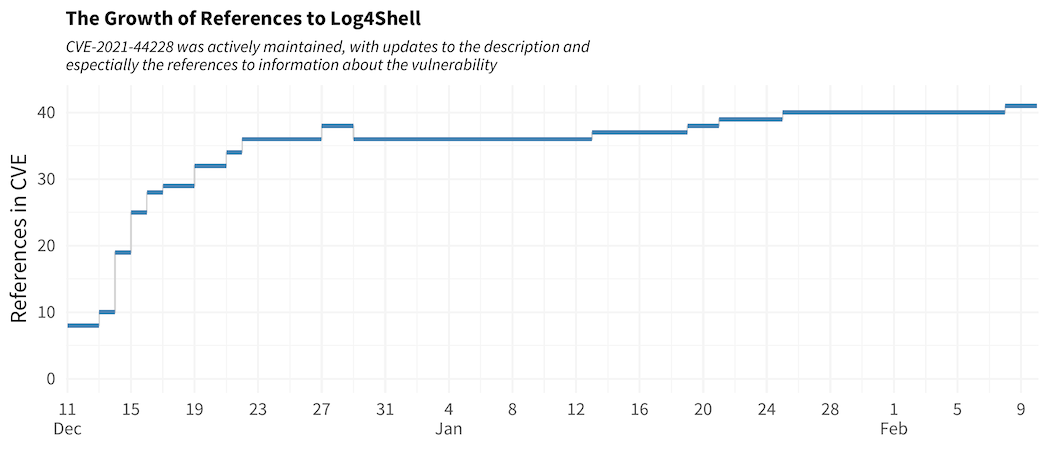EPSS vs Log4Shell
By Jay Jacobs
Let’s get two things out there up front.
First, when a vulnerability like
CVE-2021-44228
(Log4Shell) comes along, there are two reasons people will check a
scoring system, either to point out how dumb it is for being too low or
to find more support for what everyone already knows: this vulnerability
is bad. In other words, for a vulnerability like CVE-2021-44228, there
is little benefit from a scoring system like EPSS. Clearly, the
vulnerability required (still requires) immediate response regardless of
whatever any scoring system said. EPSS is more valuable when you don’t
know if something is actively being exploited or not.
Secondly, CVE-2021-44228 is in rarefied air among vulnerabilities.
Holding up a vulnerability like this isn’t going to represent the other
tens of thousands of vulnerabilities that didn’t generate the news
articles and tweet storms. Most vulnerabilities do not receive this
level of dissection and scrutiny. Vulnerabilities over the last few
years have an average of 2 references (URLs), CVE-2021-44228 has over forty. As far as testing a prioritization strategy, this vulnerability is
about handling an outlier, not a representative example.
Having set that up, we are now going to (kind of) violate the second
point above. We want to use the Log4Shell vulnerability as a use case,
but not to gauge how well or poorly EPSS did on it. Instead we want it
as a use case precisely because it was so heavily dissected and thus,
memorable. Many people have intimate knowledge of how reality unfolded
in early December of 2021, and they can compare their own knowledge to
what EPSS saw and how EPSS handled the information coming in about
CVE-2021-44228. Hopefully this will peel back the covers a bit and help
build your understanding of what EPSS is and what it is not.
How EPSS works
The Exploit Prediction Score System (EPSS) is a fully automated
vulnerability scoring system and estimates the probability of
exploitation activity in the next 30 days. And even though EPSS may be
labeled by some as “advanced artificial intelligence”, it may appear at
times to be neither advanced nor intelligent. It only knows about what
is in the data it’s consuming and parsing on a daily basis. It won’t
pick up all the same clues human analysts would find, but it will go
through millions of data points faster than any analyst could and it
will discover complex patterns and make connections with similar events
more consistently than any human could.
Within EPSS, the value of any single point of information isn’t set in
stone, in other words, the variables will have different importance
depending on the context and specifics of each vulnerability. There are
interaction effects between variables and the “weight” of a variable is
dependent on other variables. The importance of some variables can
change with time, or be influenced based on the presence of other
attributes. Additionally the importance of any single value can change
over its range. For example, as we will see in a bit, the number of
references added to the CVE has heavy influence early on in this
vulnerability, but as more and more references are added, the effect
wanes and ends up with no noticeable impact on the score in this case
even though more references are being added.
The EPSS timeline of CVE-2021-44228
This is the summary of what EPSS observed and how it reacted to
Log4Shell:

Some of the details are missing from that plot, so this is the daily
break down of what was known about this vulnerability and when:
Early December:
- Lots of activity around this vulnerability, but EPSS is completely
unaware of it. The official CVE, CVE-2021-44228 was published on
December 10th, 2021. EPSS published it’s daily scores on the morning
of December 10th without any reference to the CVE, so it was
published later in the day.
December 11, 2021: EPSS 0.355
- CVE published with 8 URLs listed as references in the original CVE.
- At least one exploit was already identified on GitHub,
- The scanner Intrigue has a module to scan for this CVE
- Based on the descriptive text, it’s tagged as “Remote”, “Code
Execution” and “Configuration”
December 12, 2021: EPSS 0.355
- The scanner Nuclei added a module to scan for this CVE
December 13, 2021: EPSS 0.384
- Two more URLs added as references in CVE (10 total)
December 14, 2021: EPSS 0.30
- Nine more URLs added as references in CVE (19 total)
- CVE description is modified and tag of “remote” is dropped (this is
probably why the score dropped on this day)
- CVSS added to NVD, with base_score of 10:
CVSS:3.1/AV:N/AC:L/PR:N/UI:N/S:C/C:H/I:H/A:H
- Apache added as vendor in CPE information
December 15, 2021: EPSS 0.633
- Exploit Code published to ExploitDB
- Six more URLs added as references in CVE (25 total)
December 16, 2021: EPSS 0.633
- Three more URLs added as references in CVE (28 total)
December 17, 2021: EPSS 0.944
- Metasploit added module, “auxiliary/scanner/http/log4shell_scanner”
- One more URL added as reference in CVE (29 total)
- NVD added Cisco, Debian, Fedora project, Intel, Netapp, Siemens and
Sonicwall in CPE information
December 18, 2021: EPSS 0.633
- Metasploit module removed
- URL references are being added into the CVE without effect on EPSS
score
January 12, 2022: EPSS 0.944
- Metasploit added module,
“exploit/multi/http/log4shell_header_injection”
- Has since maintained this score for several weeks now
There is a lot to unpack there, but let’s walk through some key points.
- First, notice something that isn’t in the chart or list mentioned
above. There was activity before the CVE was officially published
and none of it was registered with EPSS. EPSS scoring is only
triggered on CVE publication. This isn’t suggesting that only
published CVEs are important, we are just tackling what we can and
iterating improvements from there. Pre-CVE or non-CVE
vulnerabilities are important, but we are tackling one challenge at
a time and hopefully we can release more and better features in the
future.
- The publication and sharing of exploit code greatly increases the
probability of observing exploitation. All of the big increases in
exploitability are from exploit code being made available. Keep in
mind, that isn’t subjective weighting. The EPSS algorithm learns
from exploitation activity, and it clearly found a strong
relationship between exploit code being published in GitHub, Exploit
DB and metasploit and observed exploitation activity. This also
aligns with recent research
- As mentioned above, variable importance isn’t static. Look at the
chart below of the number of references in the published CVE over
time. But first understand that overall, the typical CVE has about
three references listed with it (in the official CVE list), but in
the last few years that’s dropped to about two references. This CVE
starts out with 8 references on the first day and within a week it
was up to 19 references. The point here is that each reference isn’t
affecting the exploitability an equal amount. The early few
increases are having a lot more influence and changes after maybe
two dozen, it doesn’t really matter any more. Another example here
is the EPSS score jump from 0.633 to 0.944 when code is published in
metasploit. Other CVEs published in metasploits may not see the same
jump of 0.311 points. In this case, there was already exploit code
published in both GitHub and ExploitDB, that most likely influenced
the weight of appearing in metasploit. But just keep in mind that
the jumps and increases

Conclusion
Hopefully this write up shines more light on what EPSS is and how it
works. It’s an automated system that is watching and learning about
vulnerabilities and is put into action by the publication of a CVE on
the official CVE List. It also has shortcomings and is not intended to
be a replacement for human intelligence. Like we said, when it comes to
a well-researched vulnerability like CVE-2021-44228, there is little
benefit from a scoring system like EPSS. Instead, the strength of EPSS
lies in the thousands of vulnerabilities that haven’t made the headlines
or that may not show up in any top 10 list. It’s collecting and
compiling data daily and scoring over 170,000 vulnerabilities with speed
and measurable accuracy.


